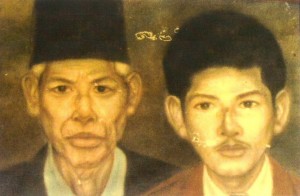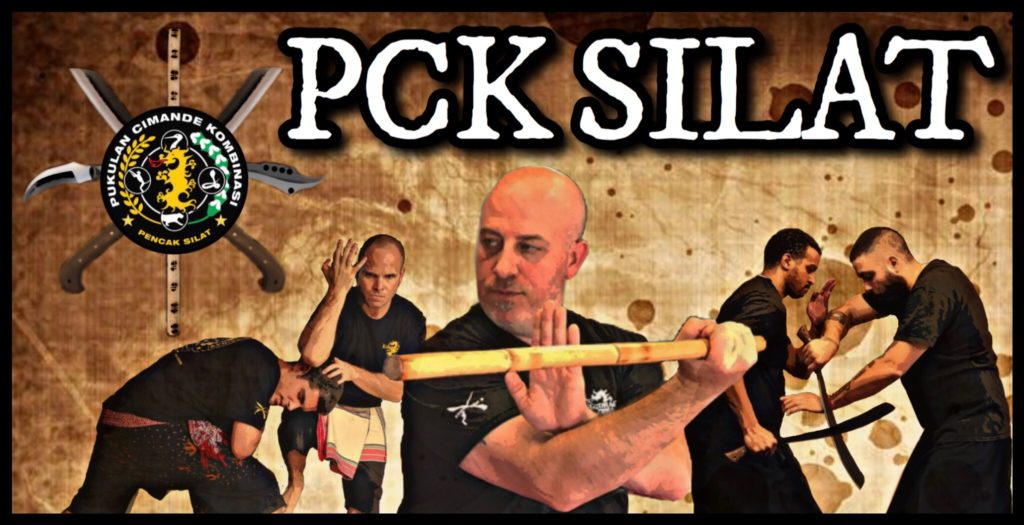SERA KOMBINASI

MAS JUD (Left)
Mas Jud's history is clouded by politics, which I will avoid here. I have drawn some of this information from the book written by William Sanders "The Real Pencak Silat and History of Mas Jud", Ian Douglas Wilson's book "The Politics of Inner Power:The Practice of Pencak Silat in West Java" and from Guru Besar Jerry Jacobs' further research. Both the Serak and Sander's groups now agree on most general information regarding his birth date, although they do not agree on much else. Both Schools tell of being in contact with Mas Juds family but both tell different stories from that point on. The date of his death is unknown but both schools tell of him being alive well into the 1960's at least.
For the sake of this page we will say that Mas Jud taught during the middle and into part of the late 1900's. He was survived by his wife and children who stayed in the Ujang Kulon area. He had 2 daughters, four sons and one adopted son. He was from Parung Kuda, Sukabumi, in the Gunung Lut area. He is said to have worked on a plantation during the pre WWII days as a teenager, where he met and trained with Cimande, Sera and Cikalong practitioners. During WWII he went to Sukabumi with his wife. In 1962 he left Sukabumi for Banten. In 1965 he moved to Cilisung. From there he moved to Cibilik, then Kampong Pondok Raksa and finally to Cikuk (spelling?). He is said to have died as late as 1990 and is buried in Tarik Kolot, Pondok Raksa.
Mas Jud learned Cimande and Sera from a teacher named H. Miftah, who is shown on our Lineage chart and is a well documented teacher of both. He also learned Cikalong from a Bapak Karta who is documented in the Cikalong Lineage . He also had a family snake system as well as Bangau, the latter probably coming from his days on the plantation.
The details of Mas Juds life may forever be clouded by the politics of the martial arts world, but in PCK Silat we speak with our fists. Mas Juds real history is in his Silat, and a trained eye can see the influences clearly. PCK Silat includes both of these lines of Sera, stemming from Sanders Mas Jud/Pak Sera Lineage as well as Kang Cecep's Sera and his training with the DeVries who are also in lines from direct students of Mas Jud. This puts us in an interesting position. We have the advantage of seeing Silat from both lineages, the similarities and the differences. We can then dissect Mas Juds art without any agenda, simply to get to the heart of his Silat. His art of Sera Kombinasi was his own. He was a skilled fighter who lived in a time where his skills would probably have been tested the hard way. The influences on his Silat are clear if you look at the Sera in Indonesia today. There is an essence to those trained in the Mas Jud line of Sera that is unique.
Master Willy Wetzel and the De Thoaurs brought his art to the U.S. and it survives here to this day. Both streams have their differences, because of the things each teacher picked up along the way and because of their own particular expression of the material. Regardless of the details of Mas Jud's history, his art is alive and well in many places.
In PCK Silat we use the Mas Jud Silat as taught by Sanders from the Wetzel Lineage. This art was a sysnthesis of mutiple styles and concepts collected by Mas Jud and later added to by Wetzel. From this stream we get less of a system of Jurus and Langka but more of an essense behind the movement. The Destructiveness of Sera, sensitivity and advanced footwork of Cikalong, the Cimande Jurus and the adaptation of those based on the Animal Silat of this stream.
Somewhere between Mas Jud and Willy Wetzel the idea of the Naga was presented. The students of Wetzel all learned about the Naga (as a Silat concept) as a synthesis of the Animal systems. The method of continuous hitting seen in the Naga movement of PCK, has traces of the Sabandar and Cikalong influences of Mas Jud. The ideas of flowing one strike into another without returning and disguising the strikes with softer appearing movement. The Naga as presented in PCK is one of the most fascinating aspects of our art and is unique to our stream as far as I know. It was further developed by William Sanders.
Mas Juds Cikalong influence can be seen in some of our sensitivity drills as well as our 8 directional footwork pattern. I believe that it is this influence, the rasa training, compared to the hard hitting of Cimande and Sera, that took his art in a new direction. We train to sense our opponent's intention through touch and rasa rather than through sight alone. We also use a relaxed style of movement between strikes to be able to sense our opponents movements and also follow the idea of relying more on feeling than action/reaction style fighting. The Sabandar concepts from Sera such as soft movements disguising the hard as well as bamboo and auditory off-timing very heavily influence our art. These influences again are seen much more in just the principles and the core essence of the movement rather than in just drills. This influence makes our art what it is and combined with the Cimande and Sera make our art well rounded, efficient and deadly.
